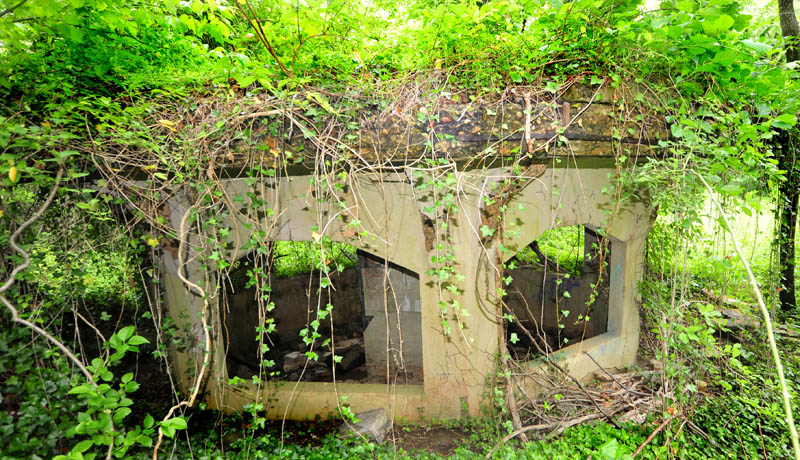West Asheville activist Steve Rassmussen will give a presentation on the current status of efforts to preserve the Sulphur Springs area this Sunday, May 20th at 3 p.m. at Malvern Hills Presbyterian Church (Bear Creek Road/Smoky Park Highway) A previous presentation at the West Asheville Library last fall sparked interest, and below are portions of an email Rasmussen sent out to the community recently
GREENWAY OVERALL: Citizens have proposed to the city of Asheville that the tract of undeveloped greenspace running from Sand Hill Road to School Road and then alongside it to the back of Goodwill and the DMV on Smoky Park/Patton be acquired and turned into a greenway, and that the historic springhouse pavilion on the tract be restored. The state’s archaeologist is willing to study this historic site when the city acquires it and requests this. It will have to be owned outright by the city in order to be turned into a greenway.
Current status: The city is interested and has been working with us, but cannot contribute any funds, so it’s up to private or nonprofit donors to make this happen. It will also be up to West Ashevillians, especially the Malvern Hills neighborhood, to tell the city just what kind of greenway we want here. (For example, whether it ought to include a community garden.)
HISTORIC PAVILION PORTION: The pavilion is on land belonging to Goodwill Industries. They are not at all interested in developing it, and are open to donating it to the city. (The development proposal Goodwill is currently pursuing would affect only their parking lotarea, not any of this property.)
Current status: We are working to create a Powerpoint presentation to send to Goodwill’s Asheville representative so he can present the proposal to Goodwill’s board.
HISTORIC GOLF-COURSE PORTION: Shortly after the Oct. 11, 2011 article in the Asheville Citizen-Times about the proposal I was contacted by an attorney for the Vrable living trust, which owns the tract (technically two properties) between Sand Hill Road and School Road. This is the site of Asheville’s first golf course, a 9-hole course designed by a pioneering golf-course architect.
Current status: The attorney, who lives in St. Louis but grew up playing in the old former clubhouse that used to stand atop the pavilion, gave me some great tips and leads to pursue, but unfortunately I know nothing about real estate, so am in over my head on this. This really needs to be pursued by someone with some real-estate background who understands concepts like “tax advantaged property exchanges and conservation land donations”. The attorney told me a couple of months ago that he might put the property on the market soon just to see what happens … so we do need to act soon!
SCHOOL ROAD PORTION: The final piece of the proposed greenway is owned by the Asheville School, and runs along one side of School Road next to Goodwill’s tract. It is steep and undeveloped, and seems unlikely to be developable. Asheville School has not been approached yet about this tract; if anyone has any contacts there, it would be great if you could let me know and perhaps help arrange a preliminary meeting. I would assume that the kinds of incentives mentioned above for the Vrable tract would also be relevant to this tract; plus the school has many wealthy alumni (including Art Pope, whose name has become familiar to those who closely follow North Carolina politics).
TOWNSHIP OAK: Near the Sand Hill Road end of the Vrable tract is the Township Oak, a centuries-old white oak that is the focal point of the “Indian’s Curse” story . It would not likely be part of the greenway per se, but is eligible to be designated a state historic landmark, and its owners—who took pains to preserve it when their building was built, in defiance of their contractor who wanted to remove it—have been working to achieve that.
Current status:I will give more details about this magnificent old tree on Sunday (including retelling the tale of the Indian’s Curse!).
GREAT BOOK TO GET: Local historian Rick Russell has published the Civil War journals of Cornelia Henry, who was the wife of the proprietor of the first Sulphur Springs Hotel, William Henry (son ofthe spring’s discoverer, Robert Henry). They are fascinating reading, especially for modern-day West Asheville residents—every time I pick the book up, I find it almost impossible to put back down! It is “Fear in North Carolina: The Civil War Journals and Letters of the Henry Family,” by Karen L. Clinard and Richard Russell, c. 2008
Reminiscing Books.
Current status: Rick’s book is available at Bright Mountain Books and Amazon online, and he says they may still be carrying it at Malaprops and Barnes and Noble.
* DONATIONS: Any donations you’d like to make to support preserving and publicizing West Asheville’s historic and environmental treasures would be most welcome, All donations are completely Tax-deductible.




As a child my family lived in the club house and we sold the water to people. My brothers were cadies on the golf course and worked for ths vnables. So excited to find what is left of the springs.